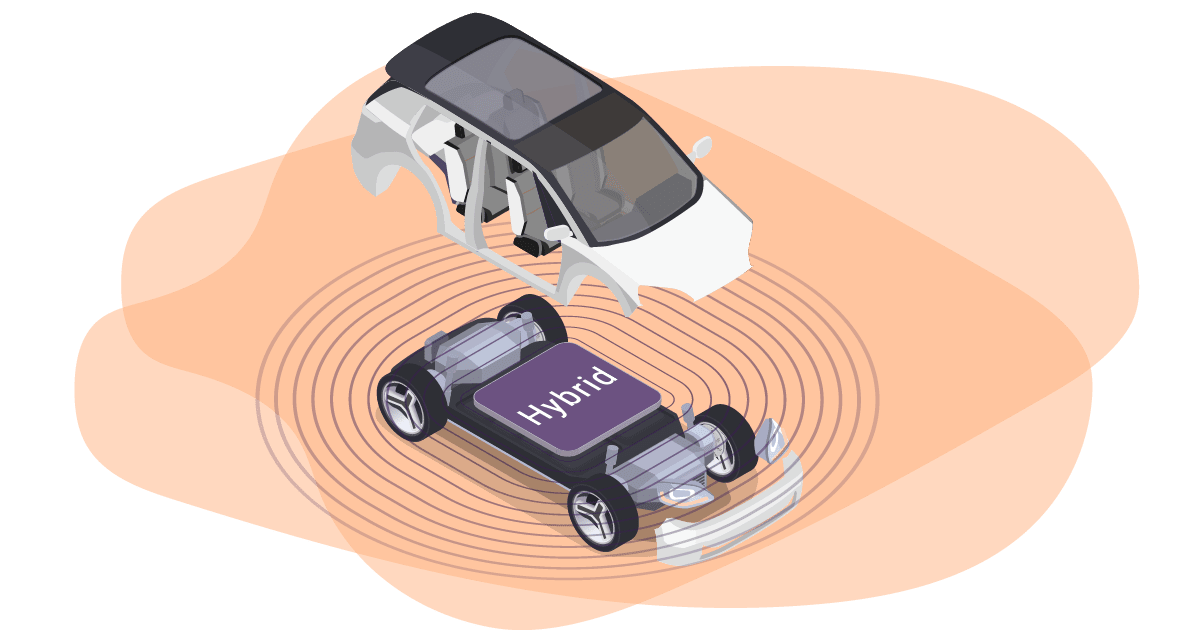Contact Info
2600 Technology Drive, Suite 100
Plano, Texas, 75074
United States
2600 Technology Drive, Suite 100
Plano, Texas, 75074
United States

Last Updated: December 20th, 2022 | E-Mobility
What exactly is a hybrid vehicle? Any vehicle that combines a minimum of two sources of energy for propulsion is a hybrid vehicle. The two sources can be gasoline or diesel fuel alongside a battery. In true hybrid vehicles, either of the source systems can individually power the vehicle. Some vehicles use fuel through a generator to charge the battery, which then propels the motor. This is not fully hybrid as it technically has only one energy source for the end propulsion. However, if the fuel and batteries – separately or together – can propel the vehicle, then it’s a true hybrid vehicle (HV).
That’s how we define a hybrid, so how does one actually work? A hybrid electric vehicle uses two sources to power an electric motor, with both sources set to achieve specific objectives: enhancing driving range, increasing fuel efficiency, or increasing the vehicle’s power.
HEVs use fuel as a primary power source and do not require an external electrical source to recharge their batteries. A true HEV has both an internal combustion engine (ICE) and an electric motor. The ICE and electric motor work together to propel the vehicle. This combination helps increase the efficiency of the engine. The power distribution allows vehicles to achieve optimum power under most driving conditions.
In this combination, the internal combustion engine drives an electric generator, not the wheels. The generator not only charges the battery but also powers the motor that propels the vehicle. This setup is also known as a range-extended electric vehicle (REEV) since the ICE powers the battery and motor but never directly controls the wheels.
For this vehicle, both ICE and electric motors propel the wheels. They work cooperatively and deliver optimum power output. The batteries in the vehicle charge while the engine works as a generator. These vehicles cannot drive in pure electric mode.
These vehicles use the ICE and the motor, with the option of working a source alone or both together. Power distribution helps the vehicle operate within its optimum range, allowing it to achieve high-efficiency performance.
Vehicles possess immense kinetic energy while in motion. When the driver applies vehicle brakes to stop, that kinetic energy needs to go somewhere. In regenerative technology, the electric motor uses resistance to slow down the wheels and stop the vehicle. During this period, the engine operates as a generator and converts the kinetic energy from the wheels into electrical energy. This energy is then stored in the batteries for later use.
Internal combustion engine vehicles require additional power in a variety of driving scenarios. For example, the vehicle needs more power when driving at slow speeds, uphill, or accelerating. This additional power historically came from burning more fuel, but in HEVs, this extra power comes from the electric motor. It also enables HEVs to have a smaller engine, increasing vehicle efficiency. At low speeds, ICEVs require maximum power to maintain control, but an HEV’s electric motor alone propels the vehicle, overriding the gas-powered engine entirely.
Some HEVs use a feature that automatically switches off the engine when the vehicle comes to a halt. This results in the vehicle conserving energy and fuel. The engine restarts by itself when the accelerator is engaged, and the drive continues as usual.
Technology for HEVs and true EVs is changing fast. Innovation in this field is making remarkable strides in developing better vehicles for the future.
| Cookie | Duration | Description |
|---|---|---|
| cookielawinfo-checkbox-analytics | 11 months | This cookie is set by GDPR Cookie Consent plugin. The cookie is used to store the user consent for the cookies in the category "Analytics". |
| cookielawinfo-checkbox-functional | 11 months | The cookie is set by GDPR cookie consent to record the user consent for the cookies in the category "Functional". |
| cookielawinfo-checkbox-necessary | 11 months | This cookie is set by GDPR Cookie Consent plugin. The cookies is used to store the user consent for the cookies in the category "Necessary". |
| cookielawinfo-checkbox-others | 11 months | This cookie is set by GDPR Cookie Consent plugin. The cookie is used to store the user consent for the cookies in the category "Other. |
| cookielawinfo-checkbox-performance | 11 months | This cookie is set by GDPR Cookie Consent plugin. The cookie is used to store the user consent for the cookies in the category "Performance". |
| viewed_cookie_policy | 11 months | The cookie is set by the GDPR Cookie Consent plugin and is used to store whether or not user has consented to the use of cookies. It does not store any personal data. |
